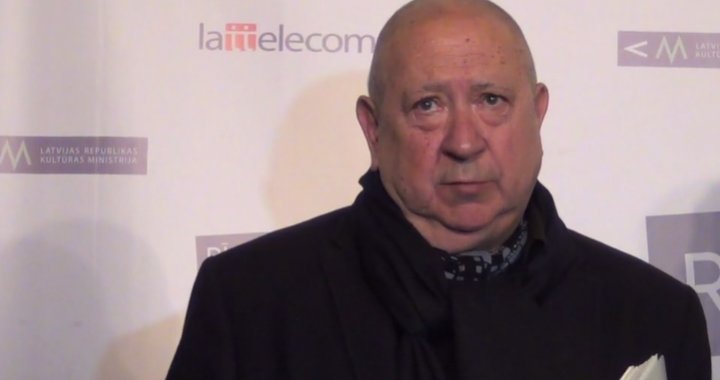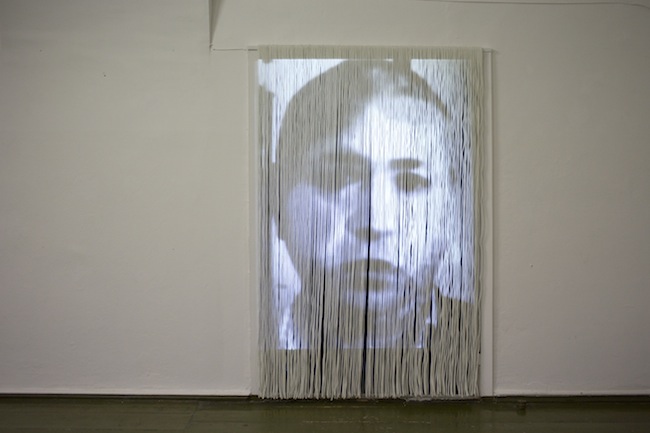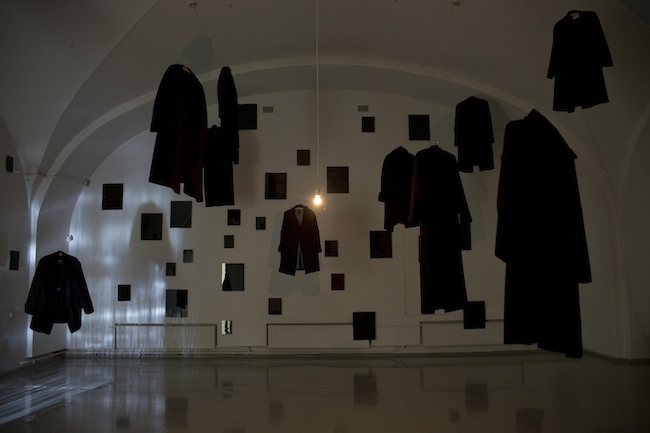
Like an Old Circus Clown
An interview with French artist, Christian Boltanski
06/02/2014
Photos: Kristīne Madjare
 Material produced with the support of ABLV Charitable Foundation
Material produced with the support of ABLV Charitable Foundation
Eight months short of his seventieth birthday, Parisian-born Christian Boltanski (1944) came to Riga for the opening of his exhibition “The Heart Archive”, in which one can not only experience his collection of recordings containing the heartbeats of the world's people (begun in 2005), but also his video installation, “Entre Temps”/“Between Times” (2003), which features portraits of the artist between the ages of six and fifty-seven.
Boltanski is represented by the prestigious Marian Goodman Gallery, and his creative career has been adorned with all of the medals a contemporary artist can possibly garner (three stints at Documenta; creator of the French national pavilion at the 54th Venice Biennale; and exhibitions at the Centre Pompidou in Paris, at the Whitechapel and Serpentine galleries in London, at the Museums of Modern Art in Chicago and Los Angeles, etc.). Boltanski has always approached the big questions of Life and Death, but in his art, he always treats these terms as if they are not capitalized. He is not interested in “the memory of humans” that has been written down in history books; he is interested in the sea of small memories that, sooner or later, get swept out into the sea of oblivion. Boltanski is enthralled by our state of simultaneous uniqueness and insignificance. Like Don Quixote, he struggles against the windmills of time, by including in his works such ephemera as photographs (e.g., his work “Menschlich”, 1994), recordings (“Les Archives du Cœr”/”The Heart Archive”, begun in 2005), and personal belongings of the deceased that, to their loved ones, serve as painful reminders of their absence (“Personnes”, at Monumenta 2010 and at the Grand Palais, in Paris).
“Ephemeral” also describes “The Heart Archive”; with it's database located on the island of Teshima, off of the coast of Japan, it is part of the “Benesse Art Site Naoshima” project. Dispersed among several “art oasis” islands, the project is the brainchild of Japanese Utopian and billionaire, Soichoro Fukutake. It is ephemeral because, one day, by holding the heartbeats of thousands of once-living people, the project will transition from an “island of life”, to an “island of death”. And not only human heartbeats can be found within it; in one interview, Boltanski reveals that the very first recording was done in Sweden, where a man asked him to record the heartbeat of his beloved dog.
Nevertheless, Boltanski sees beauty in our mortality, and not just a depressing fatefulness. He has often remarked on the “universal empathy” of which he is in possession – wishing that he could grasp and hug every person on the planet. This warmth emanates from Boltanski when I meet him in Riga – although this could also be due to the fact that he has just come from the sweltering heat of 40-degrees-plus temperatures in Australia, where he has set up (in a completely new configuration) his work “Chance”, which he made for the French pavilion at the 54th Venice Biennale. The piece consists of black and white photographs of newborns zooming down a metal track, while a tally of births and deaths appears on a large scoreboard of sorts.

Is this your first time being invited to show your works in Latvia? Or rather, is this the first time that you've accepted the invitation?
It is my first invitation. I came to Riga a year ago, to familiarize myself with the exhibition space, and now – to open the show. I have often been in Poland, and once – in Helsinki, but this is my first time in Latvia.
Your work, “The Heart Archive”, is on view in Riga, and visitors can participate in its ongoing development. Does there really exist a Japanese collector who has acquired the artwork, the archive of which is now located on an obscure Japanese island? Or, is this a myth – as you alluded to in the exhibition's press conference?
Yes, it really is true, and one really can go there and see it. The archive is found on the Japanese island of Teshima, and the collector is called Soichiro Fukutake. I'd liken him to an 18th century prince, since not only has he built several museums on the island group, but he has also altered its environment. For example, he's planted olive plantations on it, and now produces excellent olive oil. He told me that he is a Utopian, because he wants to create a “Paradise on Earth”. His choices are well-founded – he doesn't believe in an afterlife, and he has no children. That's why he invests all of his money into islands; moreover, the development of a whole cluster of islands (the “Benesse Art Site Naoshima”), including the building of museums, which he does by working with exceptional Japanese architects – such as Tadao Ando and SANAA. He is also assembling an art collection. With the development of the islands, he has raised the islands' inhabitants' standard of living – because there was nothing there before; because of the unemployment, the people were forced to move to the cities. But today, they can stay on the island and work there – like in the tourism industry, for example. “The Heart Archive” itself is on the small, uninhabited island of Ejima, not far from Teshima. There's a beautiful beach and a long tunnel leading into a mountain, in the middle of which the hearts beat.
Did this Japanese billionaire select “The Heart Archive” himself, or did you create it specially for Teshima?
He asked me to create something, and I came up with this archive – which already has around 85 thousand recordings – and which will continue to grow in size, even after my death.
Do you even like talking about your artworks? Must an artist do that?
To be an artist means to not speak with words, but rather, with artistic forms of expression. However, there is one other thing – life as art, which means having to keep up a certain mythology. For example, the island in Japan is for real, but you don't necessarily have to go there to understand the point of the piece. The story itself, the myth of the work, perhaps, is even more important than actually having the opportunity to go see the actual building that contains the archive. It's important to me to keep up the story, so that people know that there is a far-away island containing a multitude of heartbeats. Whereas, if there's a story about a Van Gogh artwork in Amsterdam, there's nothing to do, but go and see it with your own eyes. But in the case of “The Heart Archive”, in large part, just the mythology of the piece is enough to experience its wonder, as well as the knowledge that such a place exists.
So, you like the way the story of the artwork sounds?
Yes, it's the creation of a mythology. However, if I said that “The Heart Archive” is located on the Moon, that would be silly. The story must be true for the mythology to work.
Does being a famous artist mean that most people understand your art?
First of all, I'm not famous. Secondly, I believe that anyone can take what they want from my art. A good artwork is an open artwork. Everyone who looks upon my works understands what it is that he should understand. There is no one, single truth. If someone tells me: “Your art is sad”, I agree with him. If someone tells me: “Your art is fun”, I also agree with him. The job of an artist is to finish the work, but at the same time, to leave it open – unlocked.
So, your concept is not the most important thing?
Not at all. Every viewer stands in front of an artwork with his own unique baggage. In Japan, people often understand my works from a Buddhist perspective. Perhaps, in the context of the exhibition “1914”, “The Heart Archive” will translate in a completely new way again; that doesn't bother me – the work is open for interpretation.

What most encourages you to start creating something new?
In truth, I feel like a Renaissance artist fulfilling the commissions of rulers and bishops. I was just invited by a “prince” of Sydney; I was also invited by a “bishop” of Riga... That is my job, and I do it.
Do you like looking at your older artworks?
At times, it's good to read your works from anew. When creating art, you don't always notice everything that you've put into it. After ten years, it's possible to have an even more appreciative view of a work. This does not, of course, rule out the fact that there could be some older works of mine that I don't like.
Is it true that after exhibitions, you either destroy, or take apart for reuse, more than half of your works?
Yes, that's right. The exhibition in Riga is proof of this, since it was built here according to certain directions and instructions. In the spring, it will be destroyed so that, maybe five years from now, it could be installed somewhere else, from scratch. Consequently, it will both be, and not be, the same exhibition. My work is like sheet music – it can be played by various orchestras.
I take it you've been asked the following question numerous times already: Does death worry you? Scare you?
In life, art and philosophy, there are just a few essential issues. One of them is the fact that we will all die. Through art, I muse on the fact that every person is absolutely unique, but at the same time – extremely fragile. We will be forgotten soon enough. The realization that we will one day disappear is accompanied by the cognition that we are nothing special. There are only a few other questions that are just as intense – about God, sex, and the beauty of nature.
How do you, yourself, deal with this issue of death? Are you a pessimist, or an optimist?
That is the only question to which I still don't have an answer. I do not believe in an afterlife. But something that I have understood, and that makes me happy, is the fact that we will be replaced. After many years, in this same place, we will be replaced by another artist and another art critic, who will also be sitting here and talking. And that is being optimistic – to know that life will continue even without us.
Does having the career of an artist make you happy?
What a silly question... But I do think that I'm lucky to have become an artist. In some sense, it saved me. If I weren't an artist, I'd be much less happy.
Do you still paint? That's how you started out.

Oh, no. I stopped forty years ago.
I am in awe of your parents, who allowed a thirteen-year-old Christian Boltanski to stay home from school, just to paint. What gave them the audacity to listen to your wishes?
You know, I was a rather stupid little boy. I often stayed home, just to do nothing and look out the window, and I would not speak for a whole day. They were happy to see that there was at least something that interested me and kept me busy. Otherwise, I would have seemed thoroughly crazy.
Do you remember why you sulked by the window, doing nothing?
That's a very long story.
You've said that you will always be a beginner, and that the most important thing has always been “the next” artwork.
If you're an artist, then you are always a beginner. In art, you never know if you'll be able to make the next work better than the one before. In a month's time, I will be executing a new project in Sao Paulo. At the moment, it's in my head, and once again, I don't know how it will turn out, nor what it will look like, and I am, again, an anxious beginner, ready for surprises.
You have often asserted that for artists, it is important that they spend a large amount of their time doing absolutely nothing. Would you also recommend this to new contenders?
But, being an artist is not a regular job. One cannot go to the studio at eight in the morning to work at a huge canvas, only to come home at five in the evening, satisfied by a job well done. It is important to learn to live inside of your work. To merge with it completely, but at the same time, to do nothing. When I was a lecturer, I taught my students: if someone tells you that you are a complete fool, and on top of that – ugly, but then – he says that your artwork is good – then you must be happy. Nothing is more important to an artist than the work.
What do you mean by “doing nothing”?
Doing nothing means refusing to do anything that is not related to excellent art. It is a mystical experience.
That's rather difficult to do, isn't it?
Yes, at times it is really hard. Sit, look at a wall, and understand nothing. It's scary. You don't know if God is with you at that moment. A monk sits in his cell, but is unsure of God's presence. But I do not believe in God; I believe in something else.
What do you believe in?
I cannot explain it, but there is good music, and there is bad music. There are good artists, and there are bad artists.
And this, for you, is a stand-in for God?
Not at all; but at least, it is a secret – it's something difficult to describe. I was a lecturer for many years, and in that whole time, I only met five students who knew something that I didn't. They weren't smarter than me, or nicer, but they had this indescribable wonder. And from these five, some die, some quit because the life of an artist is hard, and only a rare few become great artists.
So, not everyone can be a good artist?
Anyone can become a good doctor, or a good lawyer. But rare are those who can be an artist. The thing is, there's no point in being a good artist. You must be an exceptional artist. It may be adequate to be a good doctor, but it is not adequate to be simply a good artist.
When, at the end of the interview, I requested Mr. Boltanski to sign my 1989 catalog for the Chicago exhibition of “Lessons of Darkness”, he started telling me how, in this show, he dealt with an issue that he had been preoccupied with for a long time, and how the artworks differed in form, but not in theme. This led me to ask him a few more questions:
Has anything changed conceptually in your art, since this 1989 exhibition?
In my whole life, there have been only three critical moments that, consequently, led to three paradigm shifts. The first one – when, at age 24, I understood that I had become an adult. The second – when my parents died, and which resulted in the 1989 exhibition. And the third – when, seven years ago, I realized that I had become very old. And an artist must merge together with such critical moments.
What changed in you, seven years ago?
When you become old, you don't look at life like you used to. For instance, in 1989, the fear of death did not relate to me, but to others. But now – I'm next.
And... how are you dealing with that?
(Laughs)
I mean – as an artist. Are you worried that, at some point, you won't be able to create art anymore?
I really hope that I die in some far corner of the earth, while making an exhibition. Like an old circus clown who dies while still on the road.